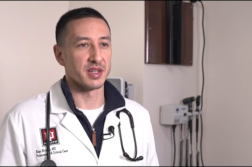LOS ANGELES, Calif. (Ivanhoe Newswire) – Breathing is something most of us take for granted; we don’t even think about it. But for some, just this simple task of taking air in and out gets harder as they age. More than 100,000 seniors suffer from something called idiopathic pulmonary fibrosis, or IPF. There is no cure but now, doctors are one step closer to stopping its progression and reversing it.
Most of us take about 16 breaths a minute – that’s 960 breaths an hour, 23,000 breaths a day, and eight million breaths a year. But some don’t take a single breath for granted.
“Idiopathic pulmonary fibrosis is a lung disease in which the lungs form scar tissue,” explains Director of the Lung Institute at Cedars-Sinai, Paul Noble, MD.
There’s no known cause for IPF.
“They either get a lung transplant or succumb to the disease within five years. The prognosis is worse than many cancers,” Dr. Noble further explains.
Researchers at Cedars-Sinai have now identified a root cause of IPF. They found stem cells lining the air sacs in the lungs lose their ability to process zinc.
Dr. Noble says, “Zinc is an essential mineral. It’s a nutrient that’s used for a lot of cellular processes.”
IPF lungs are missing a protein called zinc transporter eight, or ZIP8, which draws zinc into the cell. When researchers fed mice zinc supplements, their fibrosis improved. When they added a combination of NAD+ and Sirtuin1 activators, all of which are supplements sold over the counter, the fibrosis improved, even reversed.
“The idea of potentially improving lung function is something that really gets me out of bed in the morning,” Dr. Noble expresses.
Next, Dr. Noble and his team hope to develop a clinical trial and are hopeful the treatment could not only help treat IPF but could also be a treatment for long-COVID and other respiratory illnesses.
Contributors to this news report include: Marsha Lewis, Producer; Roque Correa, Videographer & Editor.
To receive a free weekly e-mail on medical breakthroughs from Ivanhoe, sign up at: http://www.ivanhoe.com/ftk
Sources:
https://www.cedars-sinai.org/newsroom/zinc-found-to-play-an-important-role-in-lung-fibrosis/
https://www.healthline.com/health/normal-respiratory-rate
MEDICAL BREAKTHROUGHS
RESEARCH SUMMARY
TOPIC: EVERY BREATH YOU TAKE: ZINC TO THE RESCUE
REPORT: MB #5107
BACKGROUND: Idiopathic pulmonary fibrosis (IPF) is a condition in which the lungs become scarred and breathing becomes increasingly difficult. It’s not clear what causes it, but it usually affects people who are around 70 to 75 years old and is rare in people under 50. According to the National Institutes of Health (NIH), about 100,000 people in the United States have IPF. Approximately 30,000 to 40,000 new cases are diagnosed each year. Worldwide, IPF affects 13 to 20 out of every 100,000 people.
(Source: https://www.nhs.uk/conditions/idiopathic-pulmonary-fibrosis/
https://www.healthline.com/health/managing-idiopathic-pulmonary-fibrosis/ipf-facts#prevalence)
DIAGNOSING: You can have idiopathic pulmonary fibrosis for a long time without noticing any symptoms. After many years, the scarring in your lungs gets worse, and you might have a dry, hacking cough that doesn’t go away, chest pain or tightness, leg swelling, loss of appetite, shortness of breath, especially when you walk or do other activities, feeling more tired than usual, joint and muscle aches, weight loss without trying, or clubbing, when the tips of your fingers and toes get wider. Doctors can diagnose IPF with chest x-rays, exercise tests, high-resolution chest CT, a biopsy, pulse oximetry and arterial blood gas tests, or spirometry.
(Source: https://www.webmd.com/lung/what-is-idiopathic-pulmonary-fibrosis)
NEW TECHNOLOGY: Boehringer Ingelheim has announced Phase II data for BI 1015550, a novel investigational phosphodiesterase 4B (PDE4B) inhibitor. The promising 12-week data showed a reduction in the rate of lung function decline in patients with idiopathic pulmonary fibrosis (IPF). “These encouraging, early data showed that treatment with BI 1015550 slowed the rate of lung function decline in patients who were not on approved antifibrotics, as well as those who were taking existing antifibrotic therapy,” commented Luca Richeldi, Professor of Respiratory Medicine at the Università Cattolica del Sacro Cuore in Rome, Italy, and the Principal Investigator on the trial. BI 1015550 was granted Breakthrough Therapy Designation by the US Food and Drug Administration (FDA) in February 2022. Boehringer Ingelheim will be initiating a Phase III clinical trial programme to further investigate if BI 1015550 improves lung function in people with IPF and other forms of PPF, with the ambition to bring this medicine to patients as soon as possible.
FOR MORE INFORMATION ON THIS REPORT, PLEASE CONTACT:
Laura Coverson Martha Cartagena
Laura.coverson@cshs.org martha.cartagena@cshs.org
If this story or any other Ivanhoe story has impacted your life or prompted you or someone you know to seek or change treatments, please let us know by contacting Marjorie Bekaert Thomas at mthomas@ivanhoe.com




